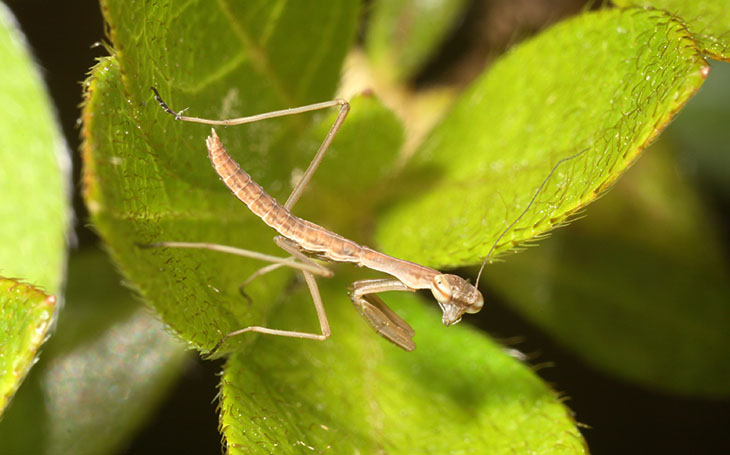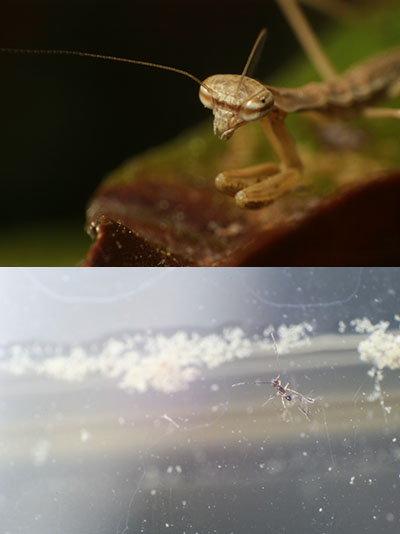
The newborn Chinese mantids have begun to disperse into different locations; I have spotted them not only on the azalea bush neighboring the one they were born within, but many meters away near other flowers and on the dog fennel plants. This makes me self-conscious, because they have to cross some sizable (to them) patches of open lawn to do so, and I’m always concerned about stepping on one making the long trek. There isn’t much I could do, save making all activities in the yard painstakingly slow as I look for a little brownish reed about a centimeter in length, so I simply tell myself that these kind of hazards are faced by the species all the time – that’s why so many are born at once. Of all the hatchlings from last year, only one that I know of reached adulthood to produce an egg sac, the progenitor of these. Others might have spread to other locations, but considering that dozens had hatched out, a solitary local remnant gives some indication of a high mortality rate.
They’re still quite shy, but slightly less so now, and with patience I can slip in close to do the portraits that I like.

Shots like this are very hit-or-miss – I have to lean over the bush in an awkward position to get this close, and holding steady in the narrow focus range is… well, actually not at all within my abilities – I usually just try to time my swaying to trip the shutter right as the subject weaves into focus. This is a keeper among many discards.
I went out later to try and get a semi-accurate measurement, to give a decent idea of size. Shocking as this may seem, the mantids aren’t inclined to hold perfectly still while I close a set of calipers near their heads, but the estimate is that my subject here measures perhaps slightly over a millimeter across the width of the head, certainly less than two. I’m pleased that I even captured the facets of the eyes, but it’s safe to say this is the limit of resolution for this rig (the defunct 28-105 reversed at 28mm.) Note the antenna that’s pointed towards us, going way out of focus – and this is taken at about f16. The depth-of-field is not going to get much better. In fact, this indicates that the other antenna was very close to being parallel to the focal plane (i.e, the digital sensor,) since it would have started going out of focus itself otherwise.
Now, another curiosity. While getting the images seen two posts back, a tiny flying insect wandered up the glass of the macro tank, and I took the opportunity to snag a quick frame before it flew off. Only after unloading the memory card did I realize I caught something very peculiar, something I’d never seen nor heard of before.

Those ‘wings’ completely messed me up – they were barely visible in the viewfinder, certainly not in enough detail to see their bizarre nature. It took a little poking around to discover that this is a species of fairyfly, or the Mymaridae family – actually a class of wasp, but hardly one anybody has any reason to be frightened of. Near as I can tell, this is a genus Mymar, but I’m not going to put money on it. The family is one of the parasitic wasps, but unlike those found at that link; these lay their eggs within the eggs of other insects, whereupon they hatch out and burrow into the hatching larva of their hosts – not exactly sporting from our perspective. It is the arthropod equivalent of original sin, dooming the host from the moment of birth. In such a small package, too.
 I realize I’m using rather disparaging terms about size, from my biased perspective, so let’s drop the diminutives and look at a scale comparison. Seen here are two images shown full-frame – this is what I captured with the camera, before cropping. They were taken at the same magnification, and we already know how big the mantis is, so this makes the fairyfly less than 0.5mm in body length, stretching all the way out to maybe 2mm with the wings and antennae – little wonder I could barely make out any details. If it weren’t for the fact that I was already watching subjects behind it, with a contrasting background, I never would have spotted it at all. I look at things like this with a certain level of awe; there’s a brain in that
I realize I’m using rather disparaging terms about size, from my biased perspective, so let’s drop the diminutives and look at a scale comparison. Seen here are two images shown full-frame – this is what I captured with the camera, before cropping. They were taken at the same magnification, and we already know how big the mantis is, so this makes the fairyfly less than 0.5mm in body length, stretching all the way out to maybe 2mm with the wings and antennae – little wonder I could barely make out any details. If it weren’t for the fact that I was already watching subjects behind it, with a contrasting background, I never would have spotted it at all. I look at things like this with a certain level of awe; there’s a brain in that tiny petite head, seemingly not big enough for four or five brain cells, but it dictates exactly what kind of eggs to seek out and what to do with them, along with handling the physics of flight.
Which is an entirely different realm than birds inhabit, to say nothing of aircraft. The fluid dynamics of air, at this level, is more coherent – like water, air molecules bind and thus move together to a limited extent, and at a small scale it is almost ‘thick.’ There is the old trope of scientists saying bumblebees cannot fly, proving scientists are stupid of course – except that’s not what was said; it was said that bumblebees wings do not work in the same aerodynamic manner as birds and aircraft, which is perfectly true. Instead of using an airfoil shape to produce a downward flow from the rear (not, as a ridiculous number of sources put it, reducing air pressure on the upper surface so the wing is pushed upward by the pressure below – this fallacy of airfoils has been around way too long,) insects use the same angle-of-attack concept that allows us to ‘fly’ our hands out the window of a moving car, creating vortices of turbulent air that produce directional force. In other words, they have a highly developed method of stirring up waves, creating higher pressure in whatever direction is needed to maneuver. The downward force of a normal airfoil, highly visible in the animated gif seen on this page, is instead developed by the varying ways insect wings thrash the air, exploiting the limited cohesive effects to better advantage. The weird fanlike wings of Mymaridae, rather than just making a breeze, produce enough vortices for lifting the negligible mass of the insect’s body without needing much mass of their own, which of course lowers the energy needed to move them, or even to develop and maintain them. Efficient unto the need thereof.




















































